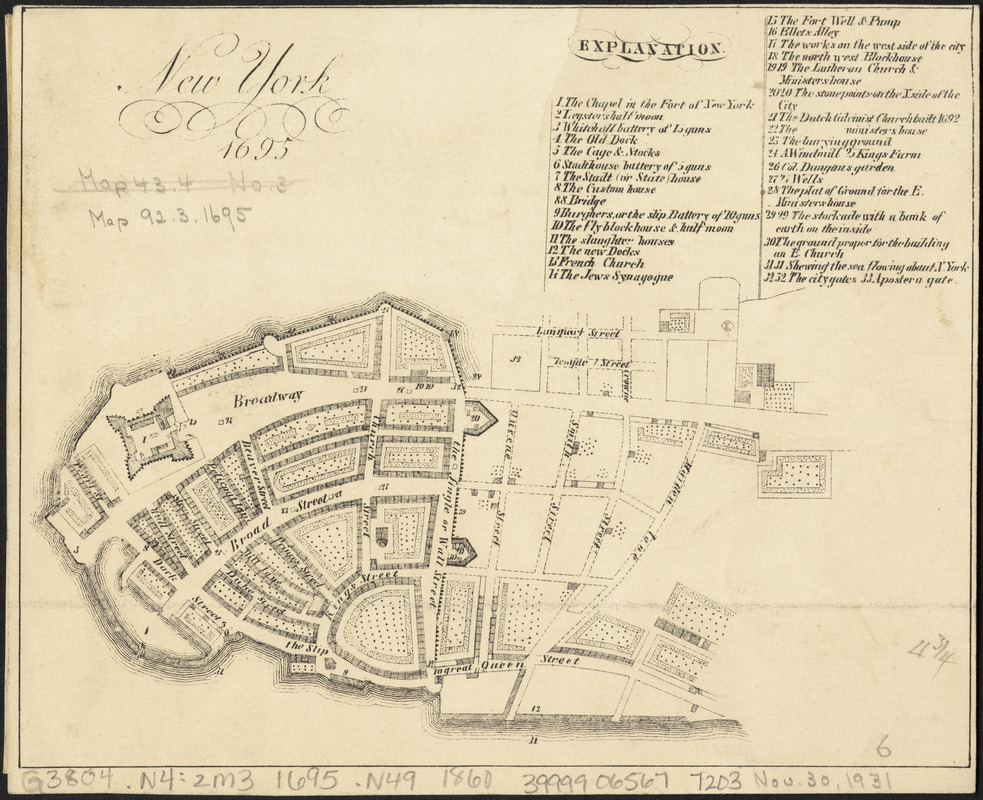48 New York in 1687

Thomas Dongan (1634-1715) was the Earl of Limerick who was sent to New York in 1682 to replace Edmund Andros as governor. He held that position for five years before transferring the governorship back to Andros in 1688. Dongan established a Post Office and and promoted religious tolerance in New York and passed an act called “The Charter of Liberties and Privileges”; although he had a contentious relationship with William Penn, due to competition in negotiations with the Iroquois over land purchases.
I send a Map by Mr. Spragg whereby your Lords may see the several Governments etc. How they lie, where the Beaver hunting is and where it will be necessary to erect our Country Forts for the securing of beaver trade and keeping the Indians in community with us.
Also it points out where there’s a great river discovered by one Lassel [La Salle, the Mississippi], a Frenchman from Canada who thereupon went into France as it’s reported brought two or three vessels with people to settle there. Which (if true) will prove not only very inconvenient to us but to the Spanish also (the river running all along from our lakes by the back of Virginia & Carolina into the Bay Mexico). And it’s believed Nova Mexico cannot be far from the mountain adjoining to it, that place being in 36d[egrees] North Latitude. If your Lordships thought it fit I could send a sloop or two from this place to discover that river.
The Correspondence we hold with our neighbors is very amicable and good. We on all occasions doing to each other all the offices of Friendship and Service we can. Which has so much endeared them to us that they desire nothing more than to be a part of this Government. Those of Connecticut choosing far rather to come under this Government than that of Boston for the reason aforementioned and the Jerseys wishing the like as having once been a part of us. And seeing that in this separation they are not so easy nor safe as they might expect to be, were they re-united to us.
The principal towns within the Government are New York, Albany, and Kingston at Esopus. All the rest are country villages. The buildings in New York & Albany are generally of stone & brick. In the country the houses are mostly new built, having two or three rooms on a floor. The Dutch are great improvers of land. New York and Albany live wholly upon trade with the Indians, England, and the West Indies. The returns for England are generally Beaver, Peltry, Oil, and Tobacco when we can have it. To the West Indies we send Flour, Bread, Peas, pork, and sometimes horses. The return from thence for the most part is rum which pays the King a considerable excise and some molasses which serves the people to make drink and pays no custom [duty]. There are about nine or ten three-mast vessels of about 80 or 100 tons burden, two or three ketches and Barks of about 40 ton, and about twenty sloops of about twenty or five-and-twenty ton belonging to the Government. All of which trade for England, Holland, and the West Indies except six or seven sloops that use the river trade to Albany and that way.
I believe for these 7 years last past there has not come over into this province twenty English, Scotch, or Irish families. But on the contrary on Long Island the people increase so fast that they complain for want of land and many remove from thence into the neighboring province. But of French there have been since my coming here several families come both from St. Christophers and England, and a great many more are expected. As also from Holland are come several Dutch families, which is another great argument of the necessity of adding to this Government the Neighboring English Colonies: that a more equal balance may be kept between his Majesty’s natural-born subjects and foreigners which latter are the most prevailing part of this Government.
Every Town ought to have a Minister. New York has first a Chaplain belonging to the Fort, of the Church of England. Secondly, a Dutch Calvinist, thirdly a French Calvinist, fourthly a Dutch Lutheran. Here be not many of the Church of England. Few Roman Catholics. Abundance of Quaker preachers, men and Women especially. Singing Quakers, Ranting Quakers, Sabbatarians, Antisabbatarians, some Anabaptists, some Independents, some Jews. In short of all sorts of opinions there are some, and the most part of none at all. The Great Church which serves both the English and the Dutch is within the Fort, which is found to be very inconvenient. Therefore I desire that there may be an order for their building another; ground already being laid out for that purpose and they wanting not money in store wherewithal to build it.
The most prevailing opinion is that of the Dutch Calvinists. It is the endeavor of all Persons here to bring up their children and servants in that opinion which themselves profess, but this I observe that they take no care of the conversion of their Slaves.
Every Town and County are obliged to maintain their own poor which makes them be so careful that no Vagabonds, Beggers, nor Idle Persons are suffered to live here. But as for the Kings natural-born subjects that live on Long Island and other parts of the Government I find it a hard task to make them pay their Ministers.
Tho. Dongan.
Source: “Condition of New York in 1687”, by Thomas Dongan, in E. B. O’Callaghan, The Documentary History of the State of New-York (Albany, 1850), I, 101-117. https://archive.org/details/in.ernet.dli.2015.45493/page/n561/mode/2up
